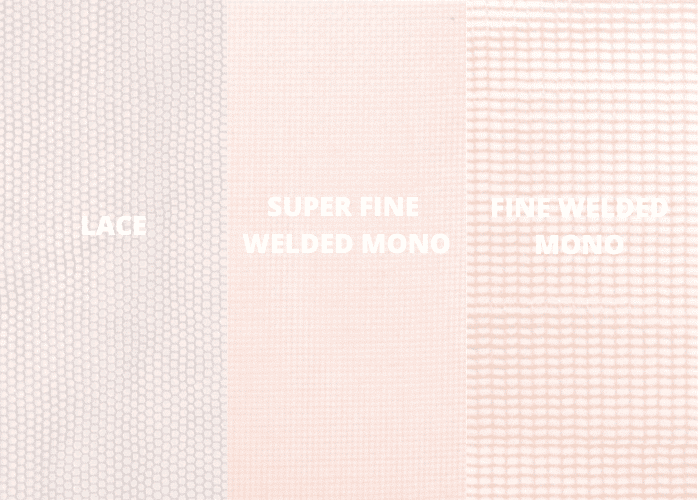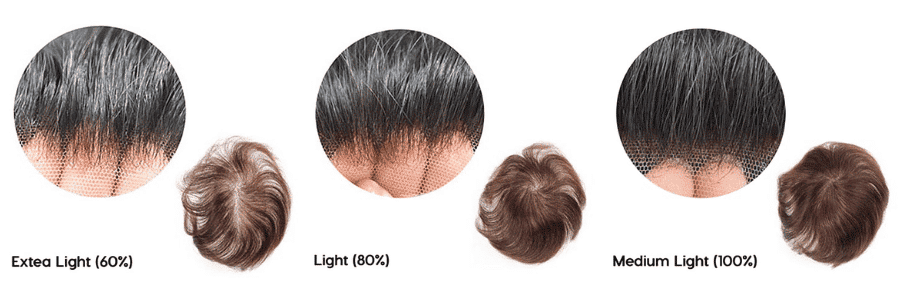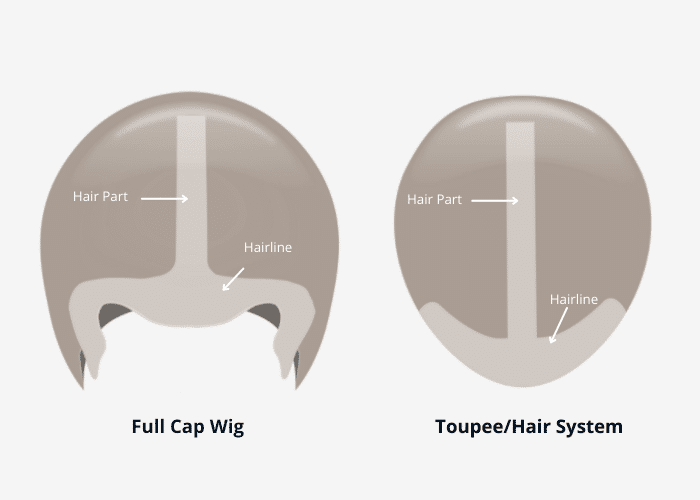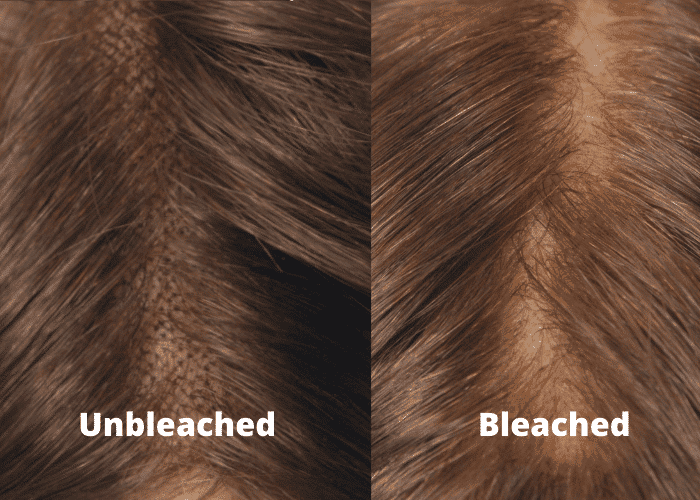Most people who invest in wigs want to have the most natural-looking wig possible. Bleaching the knots on your hair system is a valuable technique that gives your hairpiece a more natural appearance.
What do bleached knots look like and when do you need to bleach knots on your hair system? This article would help you figure out the answers to all your questions about bleached knots. It will also show you how to bleach knots on your wig at home using the same techniques used by professionals in the wig industry.
When You Need Beach Knots on Your Wig?
When manufacturers make the wig or hair systems, hair is typically attached to the lace base with all kinds of knots like single knots and double knots. These knots can be easily found when others take a close-up view of your scalp. Bleaching the knots gives them a lighter, more natural appearance. Listed below are some occasions you may need to bleach the knots on your wigs or hair systems.
Lace and Welded Mono Wigs
Typically we only use bleaching knots on the lace base and certain mono base materials like fine welded mono and super fine welded mono, as their holes are large enough to let the bleaching mixture spread through from the scalp side to the hair roots on the other side. Skin base and fine mono base are not suitable for bleaching as their holes are not large enough to allow the bleaching mixture to go through.

Light Density and Medium Light Density Wigs
Bleaching is often used on wigs of light or medium-light density levels, as there is not enough hair to cover the knots. However, the knots are nearly invisible on high and medium-density wigs, making bleaching unnecessary.

Hairline and Hair Part
Knots are most obvious on the hairline and part area of the wig, so we often bleach knots on those areas of the wig.

Bleached Knots vs. Unbleached Knots: What Is the Difference Between them?
Bleached knots are necessary for having a realistic-looking hair system, especially if your wig is a darker color. By bleaching knots on your wig, you can lighten the hair knots to a color that is close to your skin so others can not easily notice them. Unfortunately, bleaching knots often shortens the lifespan of a hair system. Since bleach both lightens and weakens the knots, they are more likely to break or shed. Because of this risk, it’s best to limit your bleaching to specific areas, such as the front hairline of your wig.

Unbleached knots will keep the original color and state of human hairs. They are more likely to be noticed by others who see you wearing your hair system. However, leaving knots unbleached will keep the original lifespan of your hair system. Since unbleached knots aren’t weakened by bleaching, they will stand up better against regular wear. This can help the wearer save money, although unbleached knots may be apparent when viewed closely.
Bleached Knots vs. Unbleached Knots: Which One is the Best Option?
Whether or not you bleach the knots on your hairpiece is primarily up to personal preference. If you want a natural-looking wig, bleached knots will make your hair system nearly undetectable. However, some people prefer a hairpiece that’s less expensive and more durable. In those cases, unbleached knots may be a better choice.
Individuals can balance durability and appearance by only bleaching a small portion of the knots on a wig. Many individuals choose to bleach the knots on the front hairline of your wig, allowing a natural appearance in this most visible area.
How to Bleach Knots on Wigs: Step-by-Step Guide
Before you start to bleach knots yourself, we have to inform you that there are risks associated with bleaching knots yourself. The darker the hair, the more difficult it is to bleach the knots. Improper bleaching can result in hair that sheds quickly and excessively. If you’re a beginner, we highly recommend you use our bleaching knots service. At New Times Hair, we offer a $10 knot-bleaching service with the purchase of your hair system.
However, if you prefer to do it yourself, the following steps will help you bleach the knots on your wig using the same techniques we use at New Times Hair.
Tools Needed:
- Bleaching powder
- Bleaching liquid
- Bowl or bleach-safe container for mixing
- A stir stick for mixing and applying the bleach mixture
- Latex gloves
- Your wig
- Access to a sink for washing
- Shampoo meant for use on hair systems
Step 1
Before you start, make sure all the necessary tools are ready. You should always wear gloves when using bleach, since it can cause irritation or chemical burns.
Once your workplace is prepared, mix the bleaching powder and bleaching liquid. It’s essential to make sure this mixture isn’t too thin, since a thinner mixture may move up the hair and beyond the root. This can ceate an unnatural look, so it’s important to make sure your mixture has a paste-like consistency.
Step 2
Carefully brush the mixture on the wig’s knots, taking care to only apply bleach to the knots in certain areas. Instead of brushing the mixture on all a wig’s knots, the best outcome happens when you focus on bleaching the knots along the front hairline of your wig.
Step 3
Leave the mixture on the knots for a while. It’s best to leave the bleach on for fifteen to thirty minutes. If you don’t leave the mixture on long enough, you won’t get your desired look. When bleach is left on too long, the bleached knots are more likely to break.
To prevent over-bleaching, carefully monitor your wig’s knots. Once the knots are light enough that they’re no longer noticeable, you’re ready to remove the mixture. If the knots on your wig become too light or too orange, you’ve probably left the mixture on too long.
Step 4
Gently wash off the bleaching mixture to prevent the bleach from changing the coloring of the entire wig. Over-bleached hair and brittle knots are the main risks of leaving the mixture on too long or failing to fully wash the wig after bleaching.
FAQs
How long do you leave the bleach on knots?
You should leave the bleach mixture on your wig’s knots for between fifteen and thirty minutes. It’s important to regularly check on your hairpiece, since some hair colors and textures may absorb bleach faster than others. You want to rinse the bleach mixture off as soon as the knots have lightened enough to give a natural appearance.
Can I bleach knots on poly skin hair systems?
The holes on poly skin bases are not large enough to allow the bleaching mixture to go through, so they aren’t ideal for knot bleaching. Typically, knot bleaching is used on lace base and certain mono base materials only.
Can I bleach knots on synthetic hair?
You cannot bleach knots on synthetic hair. Bleaching synthetic hair leaves it especially brittle, so you should only bleach knots on your human hair wigs.
Can I bleach knots on wet hair?
You can bleach knots on wet hair. However, bleaching knots on dry hair will make it easier for you to track progress during the bleaching process. Since wet hair often looks darker, you risk leaving the bleach on too long with wet hair.
Summary
Bleaching the knots on your wig is one way to make your hair system look as natural as possible. However, bleaching knots can often weaken the hair system and reduce its lifespan. Because of these risks, most people only bleach the knots on the front hairline, where unbleached knots are most noticeable.
At New Times Hair International Industries Co. LTD, we’re proud to be one of the leading manufacturers and wholesalers of high-end human hair replacement products. With markets around the world and decades of experience, we serve thousands of wholesale clients. Our toupees, wigs, toppers, hair extensions, and other products help customers around the world achieve their desired look.
New Times Hair is ready to serve you, whether you’re a large wholesaler or a small one. Our clients include online store owners, salon owners, hairstylists, and more. If you’re looking to expand your market and profits, we’re here to help.